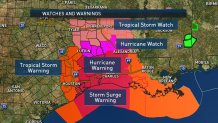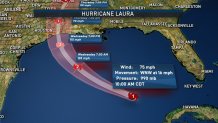Thousands of people were ordered to evacuate the Texas and Louisiana coasts Tuesday as Laura strengthened into a Category 2 hurricane early Wednesday morning.
More than 385,000 residents were told to flee the Texas cities of Beaumont, Galveston, Port Arthur and Baytown, and still more were ordered to evacuate low-lying southwestern Louisiana, where forecasters said more than 11 feet (3.35 meters) of storm surge topped by waves could submerge entire towns.
Forecasters said ocean water could push onto land along a more than 450-mile-long stretch of coast from Texas to Mississippi, and hurricane warnings will be issued later as the storm nears.
Texas Gov. Greg Abbott (R) Tuesday said the state was preparing for an event like hurricanes Ike or Rita with high, tropical force winds expected to cause devastating damage to the piney woods of East Texas.
Abbott said the latest models show the storm moving very fast and that it may be in and out of the state in a day.
The governor added 36 more Texas counties to his emergency declaration, allowing for more resources to be allocated to those areas ahead of the storm.
U.S. & World
The National Hurricane Center projected that Laura will become a Category 3 hurricane before landfall, with winds of around 115 mph (185 kph), capable of devastating damage.
"Conditions are quite favorable in the Gulf of Mexico for rapid intensification," said NBC DFW meteorologist Grant Johnson. "[A Category 3 hurricane] will be a devastating blow within a 50- to 100-mile radius of where the storm moves onshore."

While crosswinds ripped apart Marco, which still doused the region with heavy rain, there was little to keep Laura from turbocharging. Nearly all the computer simulations that forecasters rely on show rapid strengthening at some point in the next couple of days.
“The waters are warm enough everywhere there to support a major hurricane, Category 3 or even higher. The waters are very warm where the storm is now and will be for the entire path up until the Gulf Coast,” National Hurricane Center Deputy Director Ed Rappaport said Tuesday.
Laura passed Cuba after killing nearly two dozen people on the island of Hispaniola, including 20 in Haiti and 3 in the Dominican Republic, where it knocked out power and caused intense flooding. The deaths reportedly included a 10-year-old girl whose home was hit by a tree and a mother and young son crushed by a collapsing wall.
Now forecasters are turning their attention the Gulf Coast, where up to 11 feet of seawater -- storm surge -- could inundate the coastline from High Island in Texas to Morgan City, Louisiana, the hurricane center said. On top of that, up to 15 inches of rain could fall in some spots in Louisiana, said Donald Jones, a meteorologist at the National Weather Service office in Lake Charles, Louisiana -- in the bullseye of Laura's projected path.

"Whatever happens, happens. We're going to roll with the punches," said Capt. Brad Boudreaux, who operates a fishing guide service in Hackberry, Louisiana, near the Texas line.
The silver lining for U.S. coastal residents is that an earlier storm -- Marco -- greatly weakened and became a remnant just off Louisiana's shore on Tuesday. Satellite images showed a disorganized cluster of clouds. It was relegated to what meteorologists call "a naked swirl," Jones said.
The crew of a hurricane hunter plane confirmed that Laura became a hurricane with top winds of 75 mph winds (120 kmh) shortly after passing between the western tip of Cuba and Mexico’s Yucatan Peninsula. It was 625 miles (1005 kilometers) southeast of Lake Charles, Louisiana, heading west northwest at 17 mph (28 kmh).
The hurricane center warned people not to focus on the details of the official forecast, since "storm surge, wind, and rainfall hazards will extend well away from Laura's center along the Gulf Coast."
In Galveston and Port Arthur, Texas, mandatory evacuation orders went into effect at 6 a.m. Tuesday. Texas A&M University also ordered all students to evacuate the Galveston campus on Tuesday and canceled all classes for the day. The school said classes would resume remotely on Wednesday through Friday.
People planning on entering official shelters were told to bring just one bag of personal belongings each, and must “have a mask” to reduce the spread of coronavirus.
"If you decide to stay, you're staying on your own," Port Arthur Mayor Thurman Bartie said.
Voluntary evacuations were recommended for the City of Baytown and several nearby counties, including Chambers and Brazoria, according to NBC affiliate KPRC in Houston. Officials in Houston asked residents to prepare supplies in case they lose power for a few days or need to evacuate homes along the coast. Some in the area are still recovering from the devastation of Hurricane Harvey three years ago.
State emergencies were declared in Louisiana and Mississippi, and shelters opened with cots set farther apart, among other measures designed to curb infections.
Laura's unwelcome arrival comes just days before the Aug. 29 anniversary of Hurricane Katrina, which breached the levees in New Orleans, flattened much of the Mississippi coast and killed as many as 1,800 people in 2005. Hurricane Rita then struck southwest Louisiana that Sept. 24 as a Category 3 storm.
Now southwest Louisiana again faces the threat of being hit by a major hurricane, and Rita is on the mind of Ron Leleux.
"Finally we ran out of luck in 2005 with Rita," Leleux said from his home in Sulphur, where he served as mayor from 2002-2010. "When something like this comes up, I think people go back and it brings back a lot of bad memories."
In the southwest corner of Louisiana, Capt. Tommy Adams, a local fishing guide, was prepared for anything but said "you never know what's going to happen.
"I'm moving to a house a little more inland just to be on the safe side, probably about an hour north, just to be on the safe side," said Adams, who also lives in Sulphur.
In Waveland, Mississippi, a coastal town devastated by Hurricane Katrina in 2015, Jeremy Burke said "our biggest threat down here is the storm surge." When Katrina struck, "the wind did do damage, but the thing that put the nail in the coffin was the storm surge," said Burke, who owns Bay Books in nearby Bay St. Louis.
Many residents in Waveland are staying in place as Laura bears down on the coast, but they also have their cars and trucks gassed up in case the forecast grows more ominous, Burke said.
"People are prepared to possibly go at the drop of a hat," he said. "We never take a storm for granted. We might have dodged a bullet with Marco, and obviously some people along the Gulf Coast are not going to be as blessed as us."



